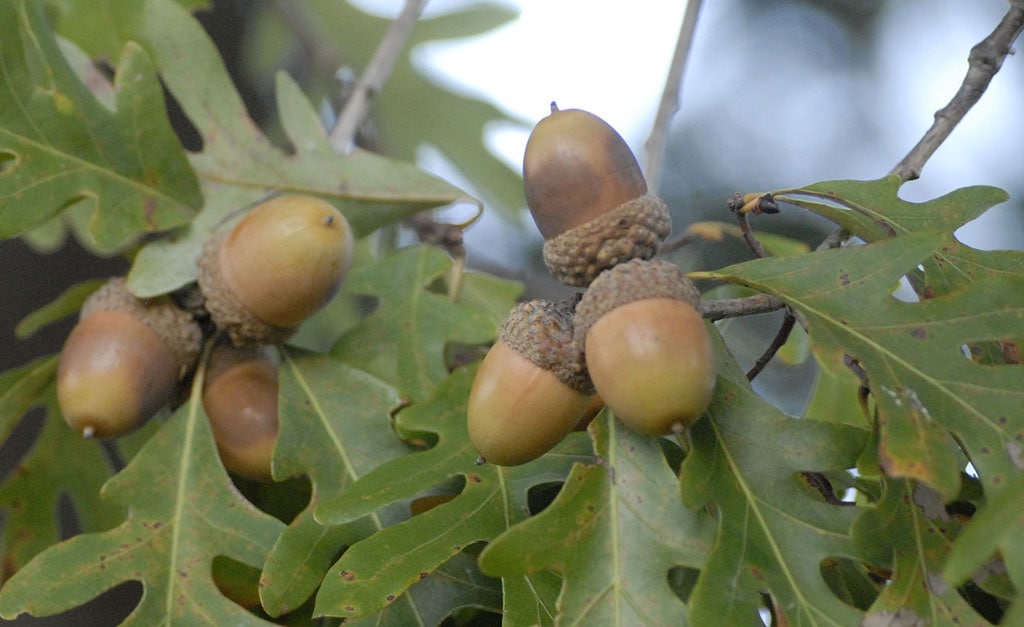
Andrew Walters | Originally published in GameKeepers: Farming for Wildlife Magazine. To subscribe, click here.
As wildlife managers, we understand the significance of hard mast producing trees, particularly oak trees. Their presence is a critical aspect of land management and arguably the best natural forage for wildlife. Oak species belong in the Fagaceae family which can be broken up into two subfamilies: the red oaks and the white oaks, which are also names for individual tree species. These are the most well-known types of oak tree species but there are many other important variations that can slip under your management radar. In order to maximize your land’s management potential, it is crucial to have a variety of oak species in both the red and white oak sections on your property. Let’s start by breaking it all down.
WHITE OAKS

hybrid.
Some of the most well-known oak trees within the white oak section are the swamp chestnut oak (Quercus michauxii), bluff oaks (Quercus austrina), overcup oaks (Quercus lyrata), chestnut oaks (Quercus montana) and of course the common white oak (Quercus alba.) All of these oak species variations germinate in the fall and their acorns mature in one growing year.
The leaves have rounded lobes and their bark is furrowed, shaggy, and lighter in color compared to red oaks. They also produce less tannic acids than red oaks. The lack of tannins makes the nut less bitter and favored by wildlife. The bitterest portion of the acorn is the very bottom where the acorn is the narrowest, opposite of the cap. This is where the majority of tannic acids are concentrated. Many animals, especially squirrels, will eat the acorn but leave the bitterest portion of the nut which is the embryo. This ensures that another crop of trees will have the opportunity to sprout the following year because the embryo is left untouched and sometimes even buried.
RED OAKS
The most well-known species in the red oak section is the northern red oak (Quercus rubra) but there are many others such as the water oak (Quercus nigra), pin oak (Quercus palustrius), black oak (Quercus velutina) and southern red oak (Quercus falcata.) These species have a darker colored bark than their cousins and when mature they will have light-colored vertical lines that run the length of the trunk. Some refer to these lines as “ski-trails” and this trademark appearance allows them to be easily recognized.
The ed oak tree’s leaves are usually more deeply lobed than white oak species and come to a distinct point. The acorns germinate in the spring and it takes two years for the acorns to mature and drop. The tree will produce acorns every year but it will have mature and immature acorns being produced on the tree simultaneously.
The increased tannin content allows the fallen acorn to be somewhat preserved on the forest floor if it is not consumed by wildlife. In a properly managed habitat, there may be times when other more palatable food sources are desired, sometimes other acorns, than the bitter red oak acorns. If this is the case it may result in red acorns left scattered on the forest floor during late winter and early spring. This provides a beneficial food source prior to the spring green-up, especially if it has been a rough winter.

bark is furrowed, shaggy, and lighter in color compared to
red oaks.
Now that we have the plethora of common types of oak trees covered we can begin describing how their presence applies to our land management. Oaks are notorious for producing a bumper crop of acorns one year then enduring a few years of mediocre production. This is a natural phase that most oak trees cycle through. This is why it is important to have a variety of species on your property. The recommended ratio of red to white oaks is three to one. Of course, the particular red and white oak species can vary. This diversity results in staggering acorn production and provides ample amounts of forage for your herd.
MAPPING IT OUT
Using aerial maps and satellite images is a technique commonly used when scouting new land. While it is tough to beat “burning boot leather,” always attempt to survey land with aerial maps before walking the property. Most oaks are deciduous, therefore they lose their leaves every year in the autumn and winter, unlike evergreen trees such as pines and cedars. Interpreting satellite maps that were pictured in the winter months allows you to differentiate between evergreens and hardwoods due to the lack of canopy cover.
Topographical maps, while not as clear as aerial maps, are still a great tool to use to overlap with aerial maps. The contour lines on topo maps distinguish the steepness of the elevation. The closer the contour lines, the steeper the slope. If the elevation reveals they are located on a slope it is most likely to be an upland species such as a northern red oak, or if it is located in low lying areas it could be a bottomland species such as a swamp chestnut oak. While the particular species is irrelevant, this allows you to locate oaks then spend your time focusing on managing the area, not spending additional time trying to locate.
PRE-EXISTING MANAGEMENT OF OAK TREES
I know what you are thinking—why don’t we just fertilize the pre-existing oaks to increase mast production? While that sounds great in theory, releasing the crop trees will have a much bigger impact. This is done by cutting into the bark around the diameter of the undesired trees. These trees will soon die but remain standing. This allows sunlight to penetrate to the forest floor, eliminates nutrient competition, and allows the oak’s canopy to expand. The goal is to ensure that the oak trees are the dominant species in the canopy and to remove any co-dominant tree competition.
A tree’s height is directly related to the number of nutrients it takes in; while the diameter of the canopy is dictated by the amount of sunlight it receives. This also increases the amount of sunlight reaching the forest floor. This has been proven to be much more effective than fertilization and is highly recommended to increase the production of acorns. It’s estimated that roughly half of the oaks within a stand produce 90% of the acorns.

those “bumper crop trees.”
A little known factor that plays a huge role in acorn production is genetics. Like all living organisms, a tree has a unique genetic makeup, some of which may not be ideal in order to produce acorns on a regular basis. In this case, a management plan can be modified, such as removing these trees. This is why it pays to keep a close eye on your oaks and monitor the acorn production from year to year.
WHAT ABOUT BURNS?
A common misconception is that you can’t conduct a prescribed burn in stands that are primarily oak. Once an area is sectioned off to be burned, all dead wood at the base of the tree should be removed to prevent smoldering that could potentially damage the tree. The fire will creep slowly through the forest floor, being fueled only by the detritus, or the leaf litter. The flames will not be hot enough to scar the oaks but it will be enough to remove most vegetation. While the intervals can vary, it is most common to burn stands of oaks every three to five years, reducing the forest’s fuel load and favoring a shrub understory. The burns can be conducted during the growing or the dormant seasons, but doing so during the dormant season will destroy any acorns that have already fallen. A growing season burn allows the vegetation plenty of time to bounce back before the autumn and winter months, which is why many conduct burns between April and July.
PLANTING YOUR OWN OAKS
Many times oak trees are scattered throughout a property and aren’t in a distinct stand. If this is the case you are likely to have a diverse collection of oaks instead of a monoculture of a single species. Determining what your target wildlife concentrates on is the best way to modify your management strategy. While it varies from location to location, wildlife may key in on a particular species of oak over others. Determining this can help you tweak your management efforts towards a particular species. This is invaluable if you are considering planting oaks on your property.
Before you purchase any type of tree to plant on your property, you must find out if the tree variety will persist in that particular environment. Upland is a term used to describe trees that grow on sloped, well-drained areas. Bottomland is a term used to describe a low-lying area near a water source and consists of moist soils. It is important to know where you plan to plant a particular variation of oak before you purchase them.

species in the early spring.
Once an area and an oak tree species has been chosen, you must prepare the planting site properly. Mechanical preparation such as disking and tilling is used, but burning is still favored. Mowing the vegetation is the least effective method, but should be done if that’s the only option. When planting trees in a forested area, make sure there is an opening in the canopy that allows the tree to receive sunlight and be sure to remove any competing vegetation. Mossy Oak’s Nativ Nurseries offers a wide selection of previously mentioned oak varieties that can be purchased. There are dozens of packages that have a variety of oaks to fit a wide array of habitat types and wildlife uses.
Once a tree has been planted it is important to protect it from any wildlife that may damage it, primarily whitetails browsing or bucks rubbing their antlers on the trunk during the pre-rut periods, which can sometimes kill the tree. Another common problem is deer nipping the tops off of the trees before the trees are above their browse height. Once they are about five feet tall they are usually out of reach of browsing deer, but it is necessary to protect them if they are any shorter.
Cages similar to the type that monitor browse pressure on food plots can be erected around the tree. Or tree-tubes can be installed at planting time. It does absolutely no good to plant trees only to have them ruined before reaching their potential, therefore it is vital that all precautions are taken to protect them.
You can’t go wrong by managing pre-existing oaks or establishing new stands of oaks. While the trees you plant will not produce acorns immediately, you are creating something that will benefit a diverse range of wildlife species for decades to come. Likewise, your management efforts on pre-existing oaks will not only contribute to your land management experience but is a valuable investment for your future hunting experiences.



